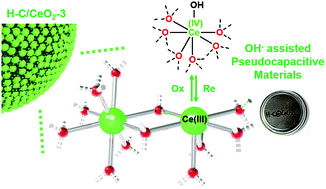Defect-rich CeO2 in a hollow carbon matrix engineered from a microporous organic platform: a hydroxide-assisted high performance pseudocapacitive material†
Abstract
A microporous organic polymer (MOP) was utilized for the engineering of nanoparticulate CeO2 in a hollow carbon matrix (H-C/CeO2). After CeO2 nanoparticles were incorporated into a hollow MOP platform (H-MOP) through the decomposition of cerium acetate, successive carbonization produced H-C/CeO2. The redox feature of defective CeO2 in a conductive carbon matrix induced promising pseudocapacitive behavior. In particular, the H-C/CeO2 showed excellent electrochemical performance in an alkaline electrolyte (KOH), due to the hydroxide ion-assisted redox behavior of defective CeO2. H-C/CeO2-3 with an optimized amount of CeO2 showed specific capacitances of up to 527 (@0.5 A g−1) and 493 F g−1 (@1 A g−1). Even at high current densities of 10 and 20 A g−1, the H-C/CeO2-3 maintained high capacitances of 458 and 440 F g−1, respectively. After 10 000 cycling tests, the H-C/CeO2-3 retained the 94–95% capacitance of the first cycle.



 Please wait while we load your content...
Please wait while we load your content...